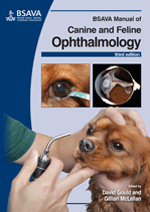
Full text loading...

Drugs may be delivered to the eye by a variety of routes. The route chosen by the clinician depends on several factors, including the intended site of action of the drug; the frequency of administration required; the ability of the drug to cross the blood-ocular barriers; potential side effects; owner compliance; patient cooperation and cost. The topical route generally reduces the risk of systemic absorption and potential side effects compared with drugs given systematically. Less commonly used routes of administration include subconjunctival, intracameral and intravitreal. The chapters looks at topical drugs preparation; antivirals; antibacterials; antifungals; parasiticides; anti-inflammatory, anti-allergy and immunosuppressive drugs; anti-glaucoma drugs; mydriatic and cycloplegic drugs; tear substitutes and stimulants; local anaesthetics; ocular irrigation solutions; anticollagenases and fibrinolytic and antifibrotic agents.
Ophthalmic drugs, Page 1 of 1
< Previous page | Next page > /docserver/preview/fulltext/10.22233/9781910443170/9781910443170.7-1.gif

Full text loading...


